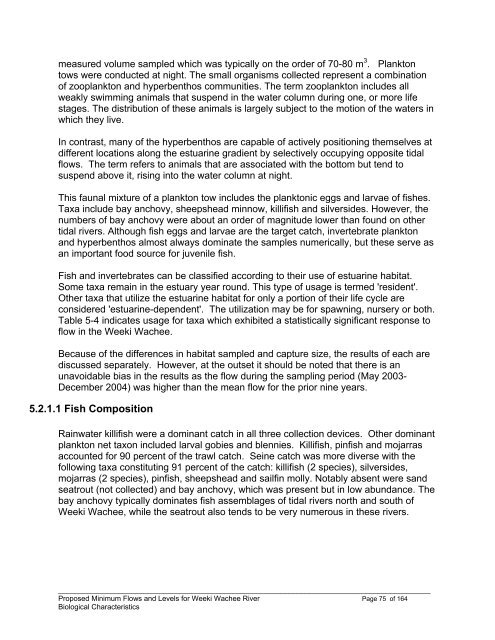Weeki Wachee River System Recommended Minimum Flows and ...
Weeki Wachee River System Recommended Minimum Flows and ...
Weeki Wachee River System Recommended Minimum Flows and ...
You also want an ePaper? Increase the reach of your titles
YUMPU automatically turns print PDFs into web optimized ePapers that Google loves.
measured volume sampled which was typically on the order of 70-80 m 3 . Plankton<br />
tows were conducted at night. The small organisms collected represent a combination<br />
of zooplankton <strong>and</strong> hyperbenthos communities. The term zooplankton includes all<br />
weakly swimming animals that suspend in the water column during one, or more life<br />
stages. The distribution of these animals is largely subject to the motion of the waters in<br />
which they live.<br />
In contrast, many of the hyperbenthos are capable of actively positioning themselves at<br />
different locations along the estuarine gradient by selectively occupying opposite tidal<br />
flows. The term refers to animals that are associated with the bottom but tend to<br />
suspend above it, rising into the water column at night.<br />
This faunal mixture of a plankton tow includes the planktonic eggs <strong>and</strong> larvae of fishes.<br />
Taxa include bay anchovy, sheepshead minnow, killifish <strong>and</strong> silversides. However, the<br />
numbers of bay anchovy were about an order of magnitude lower than found on other<br />
tidal rivers. Although fish eggs <strong>and</strong> larvae are the target catch, invertebrate plankton<br />
<strong>and</strong> hyperbenthos almost always dominate the samples numerically, but these serve as<br />
an important food source for juvenile fish.<br />
Fish <strong>and</strong> invertebrates can be classified according to their use of estuarine habitat.<br />
Some taxa remain in the estuary year round. This type of usage is termed 'resident'.<br />
Other taxa that utilize the estuarine habitat for only a portion of their life cycle are<br />
considered 'estuarine-dependent'. The utilization may be for spawning, nursery or both.<br />
Table 5-4 indicates usage for taxa which exhibited a statistically significant response to<br />
flow in the <strong>Weeki</strong> <strong>Wachee</strong>.<br />
Because of the differences in habitat sampled <strong>and</strong> capture size, the results of each are<br />
discussed separately. However, at the outset it should be noted that there is an<br />
unavoidable bias in the results as the flow during the sampling period (May 2003-<br />
December 2004) was higher than the mean flow for the prior nine years.<br />
5.2.1.1 Fish Composition<br />
Rainwater killifish were a dominant catch in all three collection devices. Other dominant<br />
plankton net taxon included larval gobies <strong>and</strong> blennies. Killifish, pinfish <strong>and</strong> mojarras<br />
accounted for 90 percent of the trawl catch. Seine catch was more diverse with the<br />
following taxa constituting 91 percent of the catch: killifish (2 species), silversides,<br />
mojarras (2 species), pinfish, sheepshead <strong>and</strong> sailfin molly. Notably absent were s<strong>and</strong><br />
seatrout (not collected) <strong>and</strong> bay anchovy, which was present but in low abundance. The<br />
bay anchovy typically dominates fish assemblages of tidal rivers north <strong>and</strong> south of<br />
<strong>Weeki</strong> <strong>Wachee</strong>, while the seatrout also tends to be very numerous in these rivers.<br />
____________________________________________________________________________________________<br />
Proposed <strong>Minimum</strong> <strong>Flows</strong> <strong>and</strong> Levels for <strong>Weeki</strong> <strong>Wachee</strong> <strong>River</strong> Page 75 of 164<br />
Biological Characteristics
















